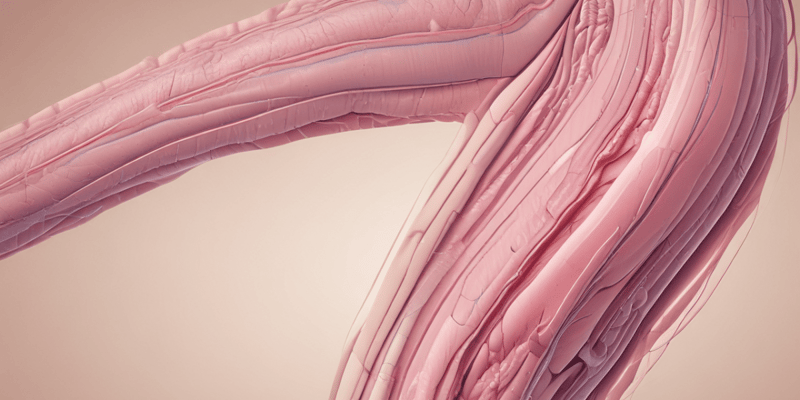Podcast
Questions and Answers
Which contraction type first appears on an empty stomach?
Which contraction type first appears on an empty stomach?
What is the interval duration between Type I contractions?
What is the interval duration between Type I contractions?
What pressure is produced by Type II contractions?
What pressure is produced by Type II contractions?
How do the tone of muscles change during Type I contractions?
How do the tone of muscles change during Type I contractions?
Signup and view all the answers
When do Type III contractions appear?
When do Type III contractions appear?
Signup and view all the answers
Which of the following organs is NOT classified as a retroperitoneal organ?
Which of the following organs is NOT classified as a retroperitoneal organ?
Signup and view all the answers
Which mechanism is NOT involved in the digestive and absorptive functions of the GI system?
Which mechanism is NOT involved in the digestive and absorptive functions of the GI system?
Signup and view all the answers
Which of the following is an example of propulsive movement in the GIT?
Which of the following is an example of propulsive movement in the GIT?
Signup and view all the answers
Which sphincter is located at the entrance from the intestine to the ileocaecal part?
Which sphincter is located at the entrance from the intestine to the ileocaecal part?
Signup and view all the answers
What initiates the reflex response of peristalsis in the GIT?
What initiates the reflex response of peristalsis in the GIT?
Signup and view all the answers
Study Notes
Types of Gastric Contractions
- Type I Contractions: First contractions occurring on an empty stomach; last for about 20 seconds, with intervals of 3-4 seconds; pressure produced is around 5 cm of H₂O.
- Type II Contractions: Arise when gastric muscle tone is stronger; last 20 seconds with reduced pauses; pressure produced ranges from 10-15 cm of H₂O.
- Type III Contractions: Occur under severe hunger; marked increase in muscle tone.
Gastrointestinal Tract (GIT) Functions
- Mechanisms for Digestion: Include softening food, propelling it through the GIT, and mixing it with bile and digestive enzymes.
- Intrinsic Smooth Muscle Properties: Play a vital role in motility, influenced by intrinsic and extrinsic reflexes, paracrine messengers, and GIT hormones.
GIT Motility Activities
- Chewing (Mastication): Occurs in the mouth.
- Swallowing (Deglutition): Involves mouth and esophagus.
- Gastric Motility: Movement within the stomach.
- Small Intestine Motility: Propulsion and mixing occur here.
- Colon Motility: Movement and absorption happen in this section.
- Defecation: Passage of feces from the body.
GIT Sphincters
- Seven major sphincters regulate passage within the GIT:
- Upper esophageal
- Lower esophageal
- Pyloric
- Ileocecal valve
- Houston's valves
- Internal anal sphincter
- External anal sphincter
Types of GIT Movements
- Propulsive Movements: Move food along the GIT (Peristalsis).
- Mixing Movements: Include churning and local contractions to ensure intestinal contents remain mixed.
Peristalsis
- Reflex initiated by stretching of the gut wall, occurring throughout the GIT from esophagus to rectum.
-
Esophageal Stages:
- Primary Peristaltic Contraction: Triggered by bolus reaching the upper esophagus; pressure enables propulsion towards the stomach.
- Secondary Peristaltic Contraction: Activated if primary contraction fails, induced by bolus distension.
Deglutition Reflex
- Involves both voluntary and involuntary actions centered in the medulla oblongata.
- Stimulus: Bolus presence in the oropharyngeal region triggers receptor activation.
- Afferent Pathway: Impulse travels via glossopharyngeal nerve to deglutition center.
- Efferent Pathway: Signals to the soft palate, pharynx, and esophagus trigger muscle contractions to facilitate swallowing.
Gastric Motility & Emptying
- Food is stored and mixed in the stomach for about 3-4 hours to form chyme before entering the duodenum.
-
Types of Movements in the Stomach:
- Hunger contractions (Type I, II, III)
- Receptive relaxation
- Peristalsis
- Filling the Stomach: Food layers arranged from greater to lesser curvature, with liquids flowing towards the pyloric end.
Gastric Emptying Process
- Swallowed food is gradually released into the intestine.
- Regulated by peristaltic waves and pyloric sphincter relaxation.
- Antrum and Pylorus: Work together to control solid and liquid food passage; more liquid contents squirt into the intestine at regulated intervals.
Studying That Suits You
Use AI to generate personalized quizzes and flashcards to suit your learning preferences.
Related Documents
Description
This quiz explores Type I contractions and their characteristics in the gastric muscles. Learn about their occurrence, duration, and frequency while understanding their physiological significance. Perfect for students studying gastroenterology or related fields.



